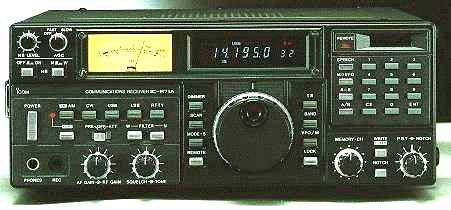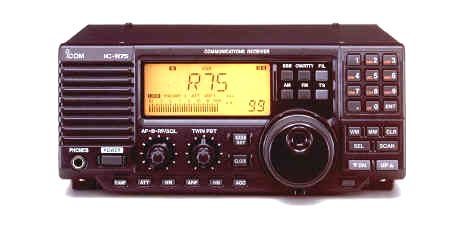

Testing the new ICOM R-75
A comparison with the ICOM IC-R71E


R75 is similar to the R71 with a high first IF (69 MHz), 9 MHz second IF and 455 kHz 3rd
IF. It has passbandtuning in both IFs. The signal path consists of 2 selectable RF-stages,
balanced JFET mixer, 2 pole crystal filter, balanced mixer, 15 kHz 9 MHz filter, Noise
gate, selectable 9 MHz 8 pole filters, IC-mixer, selectable 450 or 455 kHz filters,
detectors for AM, AM-Syncro, SSB and FM and audio section.
Equipment evaluated
R71 with FL44, 4 kHz ESKA filter, 3.1 kHz Murata CFJ455K4,
the ESKA PLAM-card and a 1024 memory card from Willco. This R71 is much better than
an original R71. I have tested it side by side with the NRD515, NRD525, AR7030 and Collins
R390 and when it comes to hard to get station it really shines!
R75 equiped with 2,8 kHz, 3,3 kHz filters and the DSP.
The attenuator below 1,6 MHz shorted.
All reception via passive antenna splitters and a preamplifer
Handling/accuracy
If you are used to the R71 you will enjoy the R75. It is like a R71 without its drawbacks. No 3 kHz jumps, no hash from the powersupply or the display. The R75 have a very flexible tuning system with steps of 1 Hz, 10 Hz, 100 Hz, 1 kHz, 5 kHz, 6.25 kHz, 9 kHz, 10 kHz, 12,5 kHz, 20 kHz, 25 kHz, 100 kHz and 1 MHz. It is possible to have different tuning steps in every mode! Tuning readout is down to the last hertz, but in practice it is hard to tune better than 10 Hz, your ears are the only tuning indicator. My R75 is about 10-15 Hz high at 21 MHz.I have not tried to adjust this error. All controls are easy to use.
Sensitivity
With my modification the R75 is at least as sensitive as the other receivers mentioned above. With the preamplifier 2 it is even more sensitive and it is possible to hear stations in the 21 MHz band which are down in the noise on my other receivers.
Selectivity
Filters in the 9 Mhz IFs are about equal in performance on both receivers. The 3,3 kHz filter in the R75 is very good. Ultimate selectivity seems to be a little better on the R75, probably due to less noise on the oscillators. The twin passbandtuning is very good. You can either use it like the Drake or AR7030, moving the passband or you can adjust the bandwidth. Passband can be shifted +/- 1,29 kHz in 15 kHz steps.
Memories
R75 has 101 memory positions, 2 are used for scanning. The memories include everything but the passbandtuning settings. I think 400 memories would have been much better.
Reception
SSB
I often tune AM stations in the SSB or PLAM mode. The R75 have a crisp and clear sound in USB/LSB and is very good for ECSS reception.
AM
The AM/AM-S is better than AM in the R71 but far from the R71E PLAM. There is no
significant difference between AM and AM.S. The AM-S locks in +/- 3 kHz or closer
depending of filter in use. The 455 kHz filter can not be used in the AM-S, just the 450
kHz cheap 6 and 15 kHz filters. I think the AM-S is a great disappointment.
Intermodulation/crossmodulation or other unwanted effects
No problems with the preamplifier1, but the preamplifier 2 is not good on crowded bands like the AM band at night. On some occasions I had some very weak signals or heterodynes when using the passbandtuning.
DSP
The automatic notchfilter is very easy to use but the maximum suppression is just 30 dB. Noise reduction sound very impressive when you push the button, but it reduces both signal and noise a lot and the real noise reduction is just a few dB, perhaps up to 4 or 5 dB. However this may be the difference between reception and no reception! The NR has 15 steps and I think a setting of 3 to 5 is good.
NB
The Noiseblanker is good on impuls noise. It is not adjustable and distorts on strong signals!
Final comments
I think the R75 is a very good alternative to the AR7030 and more expensive receivers. It performs well and is very easy to use. I recommend the extra filters, the 2,8 kHz 455 kHz filter is a good compromize if you decide for only one extra filter. I think that the R75 would be a hard to beat receiver with a better AM-S detector, more memories and another position for 455 kHz filters.
1999.09.11